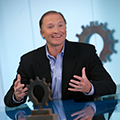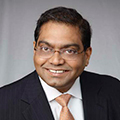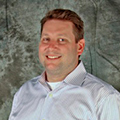Body monitoring, or the use of technology capture data and measurements related to our bodies, is an old concept that has taken a long time to take hold in the public consciousness. Largely an awareness issue that perhaps has not been helped by corporate and technological sea changes in the last two decades, the concept of body monitoring that is wearable, comfortable and useful has been most in Pittsburgh, where Carnegie Mellon University product Ivo Stivoric co-founded BodyMedia in 1999.
The company was ahead of its time, born from Stivoric’s world renowned pedigree in the field of consumer body monitoring and grown with a focus on applying the technology in the medical and consumer lifestyle management sectors. After surviving the dot.com bubble and carefully plotting twists and turns in product development based on shifts in technology and the marketplace, BodyMedia’s cache grew mightily when its multi-sensor armbands and companion software were used by contestants on the NBC reality TV weight-loss show The Biggest Loser to monitor their exertion levels, calorie burn and food intake.
BodyMedia, with more than 50 employees, is now rapidly expanding its efforts and reach. Just last week, the company was acquired by San Francisco-based Jawbone, which created UP, a lifestyle tracking wristband and app system and a series of wireless speakers and Bluetooth headsets. Not surprisingly, Bluetooth compatability, as well as a dispoable patch, are on the horizon for BodyMedia.
You’ve had a lot of success lately, which must be rewarding.
We were well ahead of our time. We thought this would happen sooner than it has, but the fact that we’ve been around 13 years means the space is pretty relevant and we’re a persistent crew over here.
How did you break into this space?
I have a background in industrial design and took a job at Carnegie Mellon heading up its wearable computer group, so for years while I was there we were doing work with multi-sensors, mini-processors worn on five- or 10-pound packs – think Google Glass 20 years ago. Our focus at Carnegie Mellon was government and industry.
What was public perception like?
When I used to talk to people about that stuff, people would say what would I use that for? Again, kind of like Google Glass. I always wanted to do something that would help people. We were doing that in the commercial and industrial markets, but we believed there was something to this idea about putting technology on the human body. What if we turn the sensors toward the body? What kind of opportunities would exist? Think about triathletes, home care, or emergency care.
What about existing products in this space?
All the products that are medical are so institutionalized. It looks like you’re sick when you wear it. There are a couple sports-related products but nothing major. So if you’re going to figure out what’s important to people in the middle ground, you’re talking about how active are you? Stress level? What do you put in your body. These are things people need to know about at the foundational level. It’s not just about health maintenance or weight loss. The next level of order of things is lifestyle issues.
So there was a clear market opening?
There was definitely a marketing opening. There was no category for this product. The biggest thing in search in our early days was health. And with these health searches, you get to something like WebMD, where all you’re doing is hitting radio buttons or doing more searches. What’s personal to you? How do you get personal? It had to be on the body.
We launched in the consumer space, but then the whole world changed (dot.com bubble followed by 9/11). We had to switch plans from going direct to consumer, which required too much cash, so we started partnering with people who had sales, marketing and distribution capabilities in these spaces and needed a product that could monitor people and deliver the service around it.
When did things start to get big for you?
Overtime, one relationship that has been long-term has been with 24-Hour Fitness. Then we got it on The Biggest Loser. Since then we’ve worked with Jenny Craig and also with many medical clinics. In 2008, we were able to get into the direct-to-consumer business because the market was shifting toward self-care and people were looking for stuff like this. We did some e-commerce through Amazon and we started to see more (competitors) show up. Now you can go to Best Buy or Target and find our stuff and other people’s stuff. People are trying to name the category still.
How do you stand out at those large retailers?
Our goal was to be consumer-friendly but medical grade so a lot of our investment early on and still has been doing clinical trials and studies to get the most quality data and to say we’re the most accurate. We’ve done thousands of subjects and shown the medical robustness of this. We’re constantly evolving our algorithms and probably have the largest database in terms of this kind of data. We continue evolve the capabilities of our system and we’ve learned over time with the outcomes of our clinical trials that our dashboard is showing two to three times more accurate results than others.
So what’s the takeaway from BodyMedia’s approach over nearly a decade and a half?
It’s about nimbleness and being ready for the opportunity when it’s there, starting slow and trying to seed it. We have a playbook for that. We have a playbook for sedding it. It takes time. We’re not selling millions of units in any sector yet, but we’re getting a lot of the right kinds of foundational groundwork set that gets us ready for those next steps.
— by Joe Petrucci


http://www.bodymedia.com/
One Gateway Center 420 Fort Duquesne Blvd., Suite 1900 Pittsburgh, Pa. 15222
↑ Top


